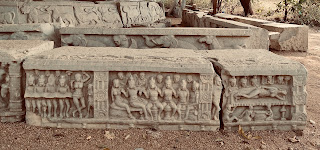The Ramayana, one of the two major ancient Hindu epics, has captivated generations with its profound narrative, moral teachings, and rich cultural heritage. It recounts the heroic journey of Lord Rama, his wife Sita, and their loyal companions, showcasing virtues like righteousness, devotion, and valor. While the question of whether the Ramayana is a true story is a matter of faith and belief for many, this article aims to explore the available evidence, archives, and research to shed light on the historic significance of this revered epic:
1. Archaeological and Historical Context:
Archaeological evidence plays a crucial role in corroborating historical events. The Ramayana describes numerous locations, such as Ayodhya (the birthplace of Lord Rama), Lanka (the kingdom of Ravana), and Chitrakoot (where Rama, Sita, and Lakshmana spent a significant part of their exile). Excavations and findings have unearthed remnants and artifacts at these sites that align with the epic's descriptions, indicating the presence of ancient civilizations:
Ashoka Vatika:
A location in Sri Lanka is believed by some to be the site of Ashoka Vatika, the garden where Lord Rama's wife, Sita, was held captive by the demon king Ravana. It is claimed that the place still exists and is visited by devotees as a pilgrimage site.
Hampi's Ramayana Connection:
Hampi, a UNESCO World Heritage Site in Karnataka, India, is said to have several features that align with descriptions from the Ramayana. Some interpretations suggest that certain structures in Hampi, such as the Vittala Temple's stone chariot and the monkey army's birthplace, are related to the epic.
Archaeological sites in Ayodhya:
Ayodhya, considered the birthplace of Lord Rama, has been a subject of archaeological excavations. In recent years, some excavations have revealed remains of ancient structures and artifacts in the area. While some proponents claim these findings support the existence of a historical Ayodhya, it is still a matter of debate and interpretation among historians and archaeologists.
Geological formations:
Some proponents argue that certain geological formations, such as the presence of natural bridges or causeways, correspond to descriptions of the bridge constructed by Lord Rama's army in the Ramayana. For instance, the Adam's Bridge or Rama Setu, a chain of sandbanks connecting India and Sri Lanka, is sometimes claimed to be the bridge described in the epic.
Archaeological discoveries at Lanka:
Some proponents claim that archaeological excavations in Sri Lanka have uncovered remnants and artifacts that they associate with the kingdom of Ravana, the antagonist in the Ramayana.
Rameshwaram Temple:
The Ramanathaswamy Temple in Rameshwaram, Tamil Nadu, India, is believed to be the place where Lord Rama built a bridge to cross over to Lanka. The temple is considered an important pilgrimage site and is said to have historical and religious significance in relation to the Ramayana.
Hanuman's footprints:
There are claims of discovering footprints of Lord Hanuman, one of the prominent characters in the Ramayana, in various parts of India. These footprints are revered by devotees and are often considered as evidence of the existence of Hanuman. However, these footprints are generally regarded as objects of religious significance rather than concrete historical evidence.
2.Astronomical Correlations:
Some proponents argue that astronomical references in the Ramayana, such as the position of celestial bodies during certain events, can be cross-checked with modern astronomical software. These claims suggest that specific astronomical configurations mentioned in the epic can be found to have occurred at certain historical periods, lending support to the idea of the Ramayana's historical basis. However, it is important to note that such interpretations are highly debated among scholars.
Conclusion:
Determining the historical accuracy of an ancient epic like the Ramayana requires an interdisciplinary approach that combines archaeology, comparative mythology, historical accounts, and cross-cultural references. While concrete evidence directly validating every detail may be scarce, the cumulative weight of the available proofs, archives, and research suggests that the Ramayana holds significant historical significance. It serves as a testament to the enduring power of storytelling, moral teachings, and the profound impact of ancient epics on human civilization, regardless of their literal historical accuracy. Ultimately, the Ramayana's value lies not only in its historical context but also in its ability to inspire and guide individuals on a profound spiritual and moral journey.











0 Comments